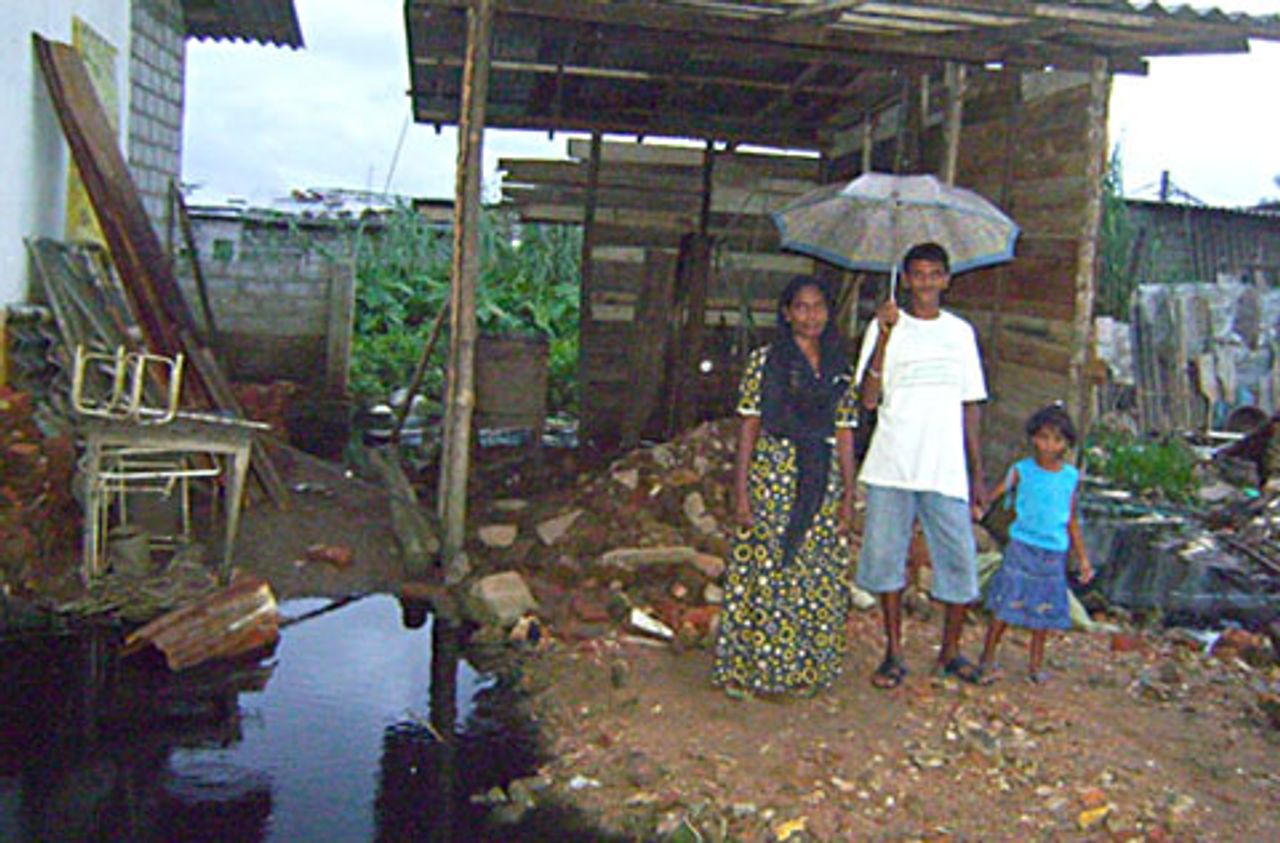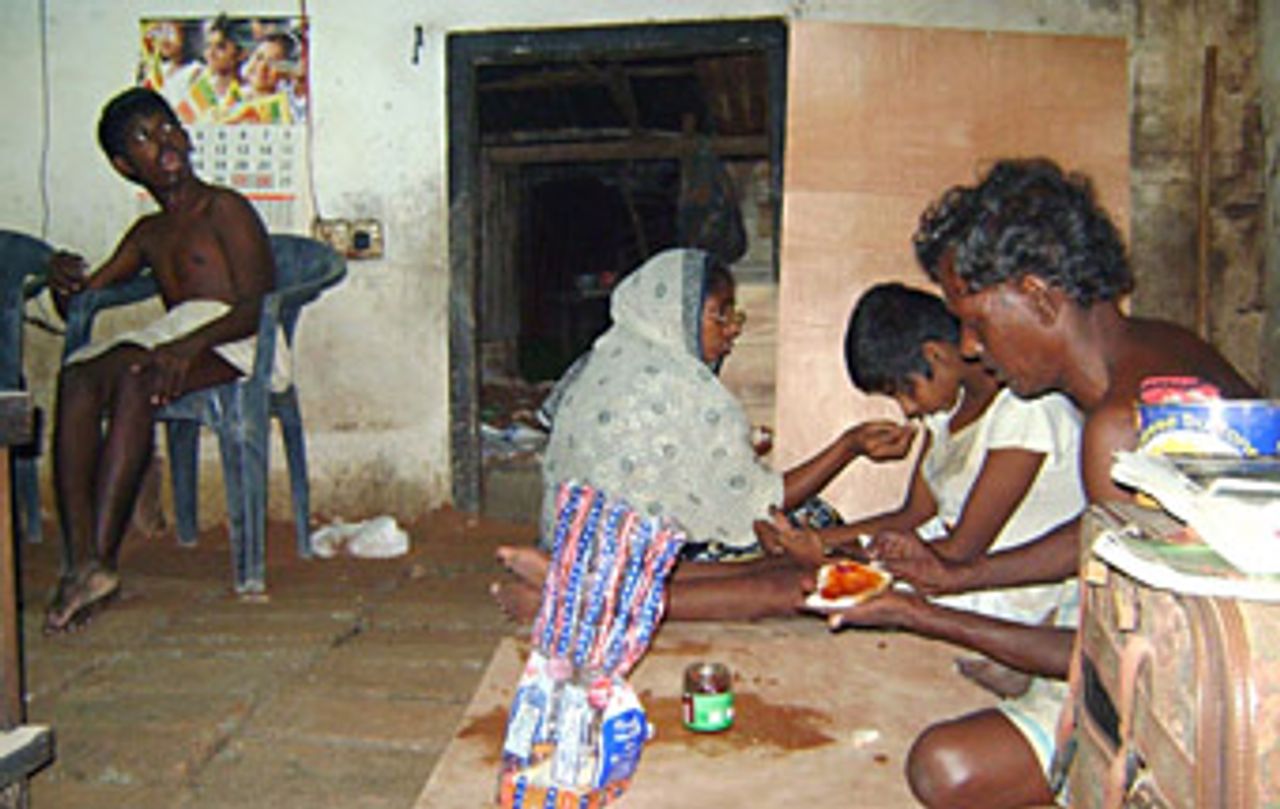More than half a million people have been affected by this month’s floods in Sri Lanka. Officially, 700 houses have been destroyed, and another 3,833 partially damaged. Around 14,000 people are still living in temporary displacement camps without basic facilities.
 Family in front of ruined home
Family in front of ruined home
President Mahinda Rajapakse’s government has failed to provide adequate relief for the victims, including food and drinking water. It has allocated just 50,000 rupees ($US438) for each demolished house, which is a pittance considering the prices of construction materials.
Instead, the government is using the floods as an excuse to evict poor slum dwellers from Colombo and other parts of the country. On May 18 Rajapakse publicly ordered “relevant authorities to evacuate residents living on canal banks to avoid flood disasters”.
In line with these instructions, Irrigation and Water Resources Management Minister Nimal Siripala de Silva this week announced that his ministry, in co-ordination with the defence ministry, was taking action to remove all unauthorised shanties erected on river banks, near marshes and on land owned by the irrigation ministry. De Silva spoke of demolitions not only in Colombo but also in Gampaha, Kalutara, and Nuwara Eliya. He declared that the government would not pay compensation to any squatters because they had taken possession of state land illegally.
De Silva insisted that the “root cause for the flooding has been identified as slums in water receding areas”. Blaming slum dwellers is hardly surprising. The government has launched a drive to clear slums in Colombo in order to release prime land for big business and investors. After the government began its second term following last month’s election, President Rajapakse placed the Urban Development Authority under the control of the defence ministry and appointed his brother, Gotabhaya Rajapakse, the ministry secretary, as its chairman.
De Silva has simply provided a new excuse for this operation against the urban poor. The defence ministry is being involved in the removal of low-lying shanties so the security forces can be used to break the resistance of slum dwellers. On May 7, hundreds of police officers and soldiers were deployed to evict 45 families from 20 houses at Slave Island in central Colombo. Over recent weeks, police also have been mobilised to remove thousands of street hawkers in Colombo, as well as in the central hills town of Kandy and the southern city of Galle.
Last week the government announced that it has stationed 15,000 security personnel throughout the island to deal with “any disaster”, including floods. The government also mobilised 1,600 Army, 400 Air Force and 500 Navy soldiers in relief operations.
The government’s accusation that slum dwellers are to blame for the flooding is doubly cynical. Some of the country’s poorest people have been forced to live in shanties because they cannot afford decent accommodation. Successive governments have failed to provide proper housing.
 Inside a small house
Inside a small houseThe poor and their shanties are not the cause of the flooding. Successive governments have also failed to develop proper drainage and flood prevention systems. On May 23, Colombo Municipal Council chief city administrator Omar Kamil told the media that the city’s drainage system was installed as far back as 1938 and was meant to cater for a population of 80,000. Today, the city’s population is estimated to be as high as 1.3 million, but no improvements have been made to the drainage system. Kamil added that a lack of funds made it difficult to develop and maintain a proper drainage system.
WSWS reporters yesterday visited Doova at Mabola, a northern Colombo suburb, where residents said about 320 houses are still affected by floodwaters, and some 200 families are unable to reach their homes. Their plight illustrates the government’s neglect and indifference toward the urban poor.
Most of the submerged homes are built with wooden planks. Although the area is prone to floods every year, the residents have nowhere else to go. The government is building a highway through the area to the international airport. The road construction was a major cause of the flooding because it dammed up the rainwater.
Suneetha’s shanty house is very close to the highway and a canal. To get to their home, her family members are using a rubber tube as a boat. She explained that 11 people, including four children, live in the wooden plank house, which has only two rooms. She described the impact of the flooding.
“The other houses are also over-crowded. Even houses made of bricks broke away. Several families have shifted to relatives’ houses. We can’t cook here, so we have to bring food from shops. Since the floods three of our family members have been suffering from fever. My husband depends on painting contracts. We have no other income.
“We have not received any compensation. Politicians came here during the election campaign but no one promised to build us houses. We voted for President Rajapakse, but all the governments are the same. Living is increasingly difficult.”
Nihara’s house collapsed completely. Her family is rebuilding the shanty with planks, with water still surrounding it. Her husband does odd jobs to maintain the family.
Mohomed explained that some people had been trapped in their houses by the floodwaters. “Some houses flooded up to the roof. Many people lost their belongings, including clothes. Not one government MP came here to see our plight.
“We are poor people. The government and the officials did not think about us when they planned the highway. They have done an injustice to us. They raised the height of the road to nine feet. The government promised to help us but we have received nothing.”
Mohomed commented about the government’s uprooting of street hawkers. “Street hawkers now don’t have a business or a job. They have no place to stay, or place to go. They can’t even feed themselves. It is unfair. The government leaders who do this, don’t know the difficulties of the poor.”
